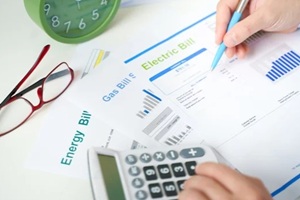A monthly electricity bill tells homeowners the total amount they owe their utility providers each month. However, they contain far more helpful information concerning long-term energy usage, energy efficiency, extra costs, and even opportunities for energy savings. These details can help homeowners make informed decisions that benefit their finances and give them more control over their monthly energy usage.
This article breaks down monthly electricity bill information to help homeowners interpret the details on their statements. By acting on this information, homeowners can switch to more renewable energy sources, reduce peak energy usage, and future-proof their finances against utility hikes.
1. Current Energy Use

The most prominent information homeowners can view on their electricity bills is their current electricity delivery charges, which are almost always on Page 1. This includes the “bill summary,” which shows the previous balance and payments, the outstanding balance, and the total amount due.
The current charges are based on how much energy the home used in the current billing period. For many homeowners, this is the most essential information on the bill.
2. Annual Usage Patterns
The current charges can say a lot about a home’s energy use. However, the annual usage pattern contextualizes this information to help homeowners track their cost increases and decreases. Most bills show annual electric usage as a graph, often with the electricity usage for each month in the current 12-month period.
On BGE’s bill, for example, it is on Page 2 under “Electric details.” It measures each month according to the electricity used (in kWh). These usage patterns can help homeowners recognize when their home consumes the most electricity by month to reduce unnecessary usage.
This is significant since high-demand energy usage, such as in the summer months, often incurs extra charges. Homeowners’ usage history can be used to reduce unnecessary electricity consumption during these high-demand periods.
3. Daily Energy Habits
Usage spikes can help homeowners understand their daily energy habits. For example, leaving lights, appliances, or electronics running all day, including during peak hours, can raise monthly bills. Higher bills can also be caused by inefficient HVAC settings, which may leave the system running when no one is home or when a fixed temperature setting would be more energy-efficient.
By observing these changes, homeowners can pinpoint the behaviors and usage times leading to their higher energy costs and identify potential long-term savings.
4. Appliance Efficiency

Rising monthly electricity bills could indicate inefficient or outdated appliances, such as HVAC systems, refrigerators, water heaters, and more. When poorly insulated or maintained, these appliances can drain power while continuing to do their job less effectively.
A gradual increase in usage during usually less energy-intensive months could indicate the need for scheduled appliance maintenance or upgrades to more energy-efficient models.
5. Insulation Quality
The quality of a home’s insulation partly determines its energy efficiency. Homes with old or worn insulation, drafty windows, and air leaks can reduce the home’s ability to retain temperature changes, forcing the HVAC system to turn on more frequently. A high energy bill may indicate that the house needs an energy efficiency audit to find insulation issues that could drain power.
6. Peak Time Usage
Just as certain months of the year are considered “peak times” for power usage, certain times of day tax power grids more than others. Peak times, usually between the afternoon and early evening, may have higher electricity costs than the rest of the day. Energy bills may list these overages as extra costs or change the pricing structure in other areas to reflect peak energy usage.
By recognizing this trend, homeowners can change their behavior to save money during peak usage times. For example, running high-energy appliances such as the dishwasher or washing machine during less strenuous hours can reduce extra energy charges on the next bill.
7. Opportunities for Energy-Saving Strategies
A high monthly electricity bill can signal opportunities for energy-saving strategies and measure the success of existing methods. When homeowners invest in solar arrays, new appliances, more insulation, better HVAC controls, or LED lighting, they can compare their monthly charges to measure their savings. If their efforts have not yielded measurable improvements, these strategies need to be expanded.
Contact Energy Select to Control Energy Usage and Reduce Your Monthly Electricity Bill

Electricity bills contain valuable information about the home’s monthly energy costs. Usage patterns, charges, and energy rates reflect the home’s energy usage behavior, the performance of its appliances, the condition of its insulation, and more.
When read properly, electricity bills can indicate opportunities to cut costs, boost energy efficiency, and make more sustainable choices. At Energy Select, our experienced team evaluates homes in Northern Virginia and Maryland to help homeowners trim their monthly electricity bills.
Our team can review electricity bills to spot areas of improvement and create a plan to increase energy efficiency and lower costs. Contact our team today to choose an energy-saving plan that makes sense for your home, including the possibility of using a new solar installation to improve sustainability and lower monthly costs.


